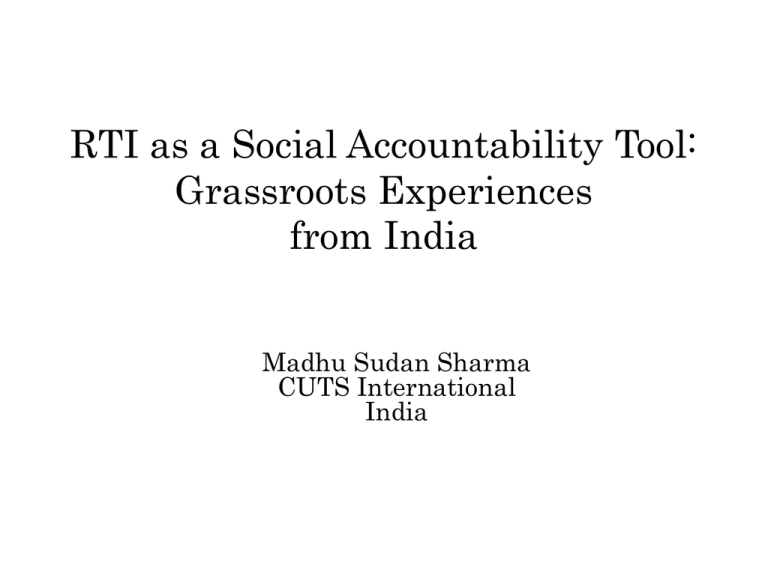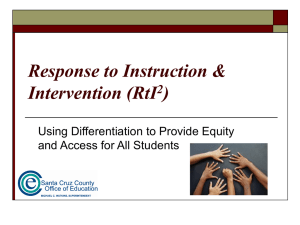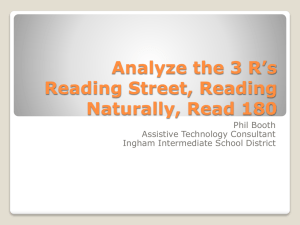RTI as a Social Accountability Tool: Indian Experiences
advertisement

RTI as a Social Accountability Tool: Grassroots Experiences from India Madhu Sudan Sharma CUTS International India Why RTI is a S. Ac. Tool • • • • • • • • • Covers all the citizenries without discrimination (wide scope than other S. Ac. tools ) Relies on Civic Engagement for exacting accountability Demand driven and operate from bottom up Complement and strengthen the formal accountability mechanism Empowers common citizenries and ensure quality of public service delivery Enhances development effectiveness Ensures transparency and access to information Enhance citizen participation and oversight Grievance redressal & System strengthening In 2005, RTI Act was over laden with expectations & Hopes of common masses Why a last person in village is, so upbeat about RTI Act, 2005 • Overnight the Status of a common man was leveled up to the M.Ps. or MLAs. • Broken the culture of secrecy and hammered on the legal, institutional and psychological barriers in the way of ATI. • Entire governance process opened up for common citizenries. • Empowered them to access the information (ATI) hold by the government (No way earlier) • Most empowering & Famous law enacted after independence of India Demand generating and Empowering Features • • • • • • • • • • • • Fundamental Right and part of Right to Freedom of speech and expression Informed Citizenry for vibrant democracy Maximum disclosure: Duty to Inform Record management and Info storage Promoting open Government: Accountability Provisions Limited scope of exceptions: Time Limit for providing information Cost is not an hindering factor Protection of Privacy and Whistleblowers Completely Hands off processes Publicity and Trainings Be Applicable for private sector as well Indian Scenario • • • • An estimated 9-10 million RTI applications till 2011 Public Authorities have been designated for receiving RTI requests at all levels Yale University study reportedly suggests that RTI works faster than paying bribes. (CUTS’ Must roll case) Also, socially equalises and empowers a man standing at last ladder (The peanut vendor’s case) Usage of RTI • • • • • • To get information that should have been in public domain in any case (Neeraja Modi /Fortes Hospital). To expose misuse of power and corruption (Panna Devi Case) Preventive use against corruption Proactive disclosure of information on walls, boards and public places (Y. Dashanan case in PHED) India Against Corruption Movement (Anna Hazare) NGOs also come under RTI if substantially funded by Government (Prayas case) Complaint redress Vs System Reforms To have grievances addressed – now a new Bill (Bicycle thief & Passport case). Judicial Activism is Good for 'Aam Adami • Few High Courts are know for being Pro-RTI and Delhi, Maharashtra and Karnataka are the main (Cases of CJI’s office and BCCI case • CICs are also very proactive (File Noting, Answer sheets, ) Breaking socio-historical barriers and achieving targets Panna Devi & Rekha Kumawat case Innovative uses of RTI • • • • To make elected representatives accountable (Attendance in committees/ Parliament, questions asked, matters pursued) People are filing requests at president’s office directly And how much water was drank by neighbor's buffalos (Mangal Gurnani) Even finding suitable grooms. Lessons Learnt at CUTS • • • • • Strategy of using the RTI in selected schemes is more result oriented (MGNREGS, IAY, SGSY) Having a network of local proactive users at local level which work effectively (CUTS CGCCs model) Media is a critical ally in the process Preventive approach rather than post mortem approach is more rewarding Creating a critical mass people related to RTI at multiples levels (Community to Government) Way of functioning A time tested CUTS-CGCCs model RGR & CVA Survey Findings: by CUTS in 2010 Application format Public Info. Officer Fee rules APL/BPL Time: 30 days’ FAAs /SAAs Common Man 26% 19% 21% 08% 7% PIOs/FAAs 82% 80% 54% 64% 22%/12% Use of RTI Act, 2005 Only 5.5% people filed RTI. Information provided (33%) Dissatisfied with info. 75%) Cases in 1st Appeal (9%) Reasons asked by PIOs Purpose (32%) Use of info. (24%) Public interest (14%) Political motivatio n (19%) Grounds of rejecti ng a RTI as PIOs Related to other department (32%), Training of PIOs (22%) Misuse of information (30%) Too many questions (17%), Misbehavi or with PIO (08%) RTI Act Provisions Cases in 2nd Appeal (0.5%) Applicatio n not clear (13%) Form Networks and Be Networked http://www.freedominfo.org/ foianet-bounces@lists.foiadvocates.info sartianetwork@yahoogroups.com Thanks mss2@cuts.org The RTI Act 2005 – Key facts • • • • • • • It is most progressive and empowering Act after independence of India The grassroots initiative for RTI was started from Rajasthan Came in to effect from Oct. 12, 2005. Covers central, state and local governments, and all bodies owned, controlled or substantially financed by Government (2(h)) Covers executive, judiciary and legislature (2(e) Includes information relating to private body which can be accessed by under any other law for the time being in force (2(f)) Key concepts: CIC, SIC, Public Authority-APIOs, PIOs, FAAs, Third Party, proactive disclosure of 17 type of information, RTI Act: Key Definitions • • • Record means: Any document, manuscript and file, Any microfilm, microfiche and facsimile copy of a document, any reproduction of image or images embodied in such microfilm (whether enlarged or not), any other material produced by a computer or any other device s.2(i) Information means: Any material in any form, including records, documents, memos, e-mails, opinions, advices, press releases, circulars, orders, logbooks, contracts, reports, papers, samples, Models, data material held in any electronic form (S.2 (f)) RTI includes the right to inspection of work, documents, records; Taking notes, extracts or certified copies of documents or records; Taking certified samples of materials, obtaining information in the form of diskettes, floppies, tapes, video cassettes or in any other electronic mode or through printouts where such information is stored in a computer or in any other device; Apply your mind before filing a RTI Application Be smarter, tactful and foolproof than PIO because it is a mind game RTI application filing process: precautions Precautions: (Pre, During Application and Post-application) • Know the possible sources of information and concerned PIO or APIO and its correct address • Frame short and concise but clear questions to be asked and must not be imaginary. Not more than three four at a time (For PIOs Assistance & Risk of penalty is less if more questions) • Be clear whether any format is prescribed or not • Demand in individual ‘s name rather than CSO’s name • Local language, full address, legibly written, time specified, required fee etc. • Think about possible reasons of rejection or ways of insufficient or misleading information as per local conditions if any. • Be clear about whether your RTI is related to any grievance of demanding any information held by PIO • Strict follow up of the filed application and reaching up the logical conclusion • Link up with media to publish your information if it has larger interest








